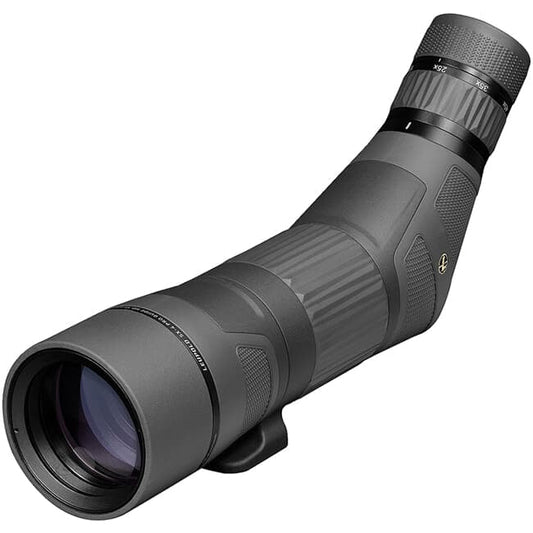

Leupold SX-4 Pro Guide Spotting Scope 15-45x65mm HD Angled offers exceptional clarity and durability for outdoor enthusiasts. Built with a rugged magnesium body, this spotting scope is completely waterproof and fogproof, ensuring reliable performance in challenging conditions. The oversized eyepiece enhances comfort during long viewing sessions, while the Twilight Max HD Light Management System maximizes visibility in low-light situations and minimizes glare. This scope is designed for serious hunters and shooters who demand quality and reliability.
With a smooth focusing system, fine adjustments are effortless, allowing you to quickly lock onto distant subjects. The built-in 1/4-20 rotating tripod adapter port ensures stability when mounted on a tripod. This spotting scope also features scratch-resistant lenses, maintaining clarity and performance over time. Leupold guarantees the SX-4 Pro Guide HD will perform for life, providing peace of mind with its lifetime warranty.
Key Features:
- RUGGED DESIGN for reliable performance in harsh conditions.
- TWILIGHT MAX HD SYSTEM enhances visibility in low light, adding up to 30 minutes of shooting light.
- SMOOTH FOCUSING allows for quick fine adjustments to capture your target effortlessly.
- TRIPOD READY with built-in 1/4-20 rotating port for stable mounting options.
- WATERPROOF & FOGPROOF integrity ensures performance in all weather conditions.
- OVERSIZED EYEPIECE provides all-day comfort with generous eye relief for extended viewing.
- GUARANTEED FOR LIFE with a lifetime warranty for peace of mind.
- SUNSHADE INTEGRATION reduces glare instantly for improved viewing in bright conditions.
Technical Specifications
| Specification | Detail |
|---|---|
| Magnification Range | 15-45x |
| Lens Diameter | 65mm |
| Weight | 62 oz |
| Length | 14.7 in |
| Angular FOV Range | 2.5-1.3 |
| Linear FOV (ft/1000 yd) | Low: 131, High: 68.1 |
| Eye Relief | Low: 20.0 mm, High: 17.6 mm |
What's in the Box?
- Spotting scope
- Lens covers
- Padded case
- Neck strap
Customer Reviews
"The clarity is outstanding, even in low light. Perfect for my hunting trips!"
"Extremely durable and easy to use. A great investment for serious shooters."
"Comfortable eyepiece makes long sessions a breeze. Highly recommend!"
FAQ
What is the effective range of the Leupold SX-4 Pro Guide Spotting Scope?
The effective range can vary based on conditions, but with its 15-45x magnification, it's designed for long-distance viewing, making it ideal for hunting and birdwatching.
How do I maintain the spotting scope?
To maintain the SX-4, keep it clean by using a soft cloth for the lenses and avoid harsh chemicals. It is also important to store it in a dry place to prevent moisture damage.
How does this compare to other spotting scopes?
Compared to others in its class, the SX-4 excels in low-light performance and durability. Its lifetime warranty further distinguishes it from many competitors, providing reassurance for long-term use.
Similar Models
Looking for more options? Check out the Leupold lineup, including the VX-3i 6.5-20x50mm for enhanced precision and the Leupold BX-4 Pro Guide HD binoculars for versatile viewing. Explore our full collection to find the perfect optics for your needs.
You May Also Like
Here’s some of our most similar products people are buying. Click to discover trending style.








